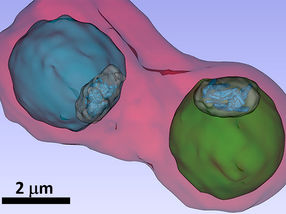Crowdsourcing site compiles new sign language for math and science
A multimedia feature in the New York Times outlines efforts in the United States and Europe to develop sign language versions of specialized terms used in science, technology, engineering and mathematics.

This is an ASL-STEM Forum screen shot, with former research team member Anna Cavender.
University of Washington
The article shares newly defined signs for terms like "light-year," "organism" and "photosynthesis." It also describes a successful crowdsourcing effort started at the University of Washington in 2008 that lets members of the deaf and hard-of-hearing community build their own guide to the evolving lexicon of science.
"It's not a dictionary," explained Richard Ladner, a UW professor of computer science and engineering. "The goal of the forum is to be constantly changing, a reflection of the current use."
A scientific and technical dictionary for American Sign Language has existed since the late 1990s. It is called Science Signs Lexicon, launched by Harry Lang, an early proponent of science in the deaf community and a professor at the National Technical Institute for the Deaf at Rochester Institute of Technology.
But a dictionary can't include the newest terms, Ladner said, and many graduate students won't find the specialized terms used in their chosen fields. For example, Ladner helped organize a 2008 workshop where a deaf scientist said only about one-quarter of his field's specialized terms existed in his native language, American Sign Language, or ASL. Many workshop participants reported that at some point they had had to work with their interpreters to develop their own code words.
That year, with funding from Google Corp. and the National Science Foundation, Ladner's group launched the ASL-STEM Forum, an online compilation of signs used in science, technology, engineering and math that is more like Wikipedia or the Urban Dictionary.
"The goal was to have one place where all these signs could be," Ladner said. "We're not trying to decide on new signs but just collect the ones that are in current use."
The site lists 6,755 terms from biology, chemistry, engineering, math and computer science textbooks. Of those, about 2,800 have video entries, some with multiple entries. Partnerships with the country's two largest higher education institutions for deaf and hard-of-hearing students have helped provide content.
Organizations
Other news from the department science

Get the chemical industry in your inbox
By submitting this form you agree that LUMITOS AG will send you the newsletter(s) selected above by email. Your data will not be passed on to third parties. Your data will be stored and processed in accordance with our data protection regulations. LUMITOS may contact you by email for the purpose of advertising or market and opinion surveys. You can revoke your consent at any time without giving reasons to LUMITOS AG, Ernst-Augustin-Str. 2, 12489 Berlin, Germany or by e-mail at revoke@lumitos.com with effect for the future. In addition, each email contains a link to unsubscribe from the corresponding newsletter.














![[Fe]-hydrogenase catalysis visualized using para-hydrogen-enhanced nuclear magnetic resonance spectroscopy](https://img.chemie.de/Portal/News/675fd46b9b54f_sBuG8s4sS.png?tr=w-712,h-534,cm-extract,x-0,y-16:n-xl)







































